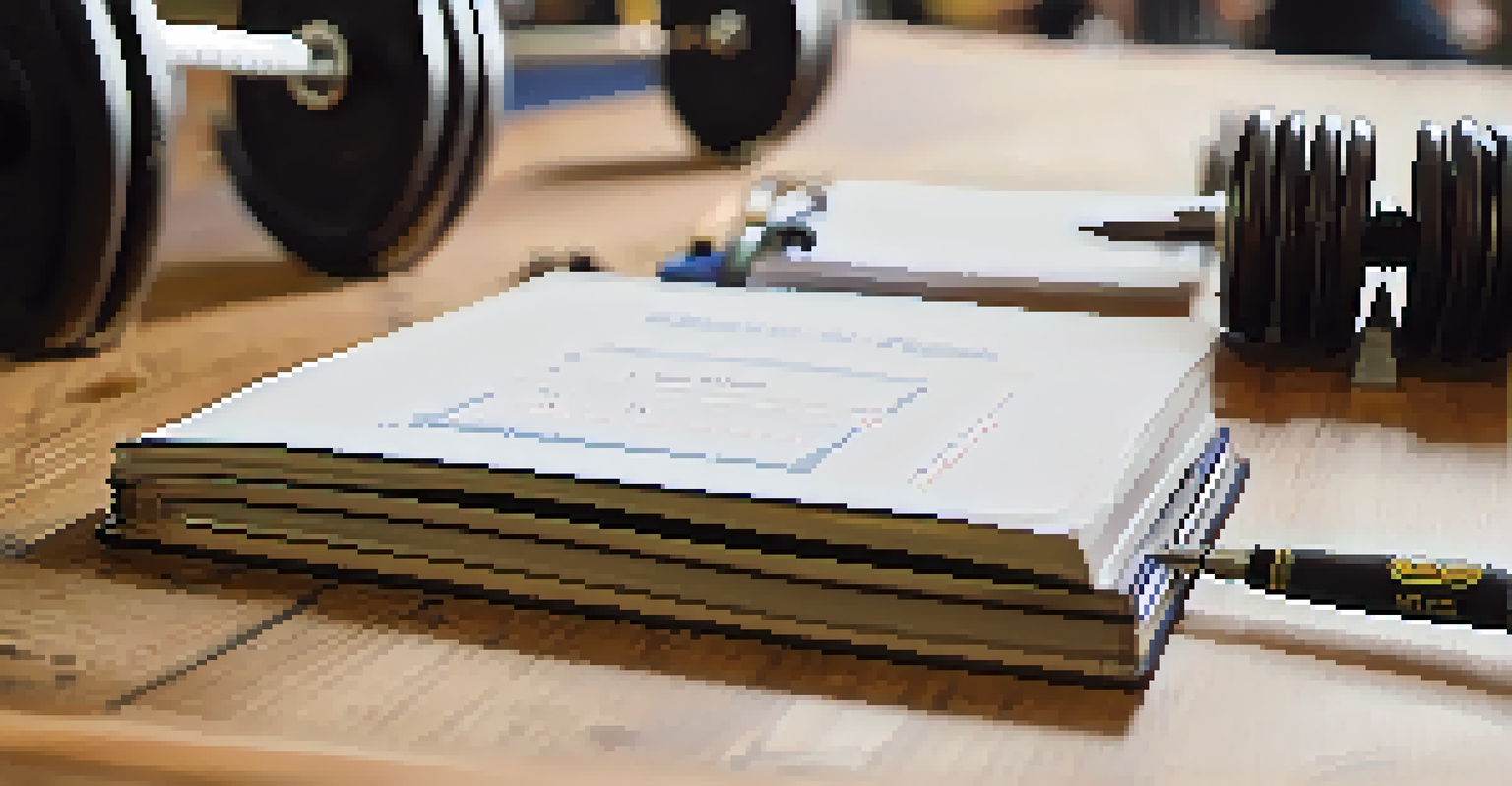Tracking Progress: Powerlifting and Goal Achievement

Understanding Powerlifting: The Basics of the Sport
Powerlifting is a strength sport focused on three main lifts: the squat, bench press, and deadlift. Each of these lifts tests different muscle groups and requires both physical strength and mental focus. By mastering these movements, athletes can showcase their strength and technique in competitions. Understanding the fundamentals of powerlifting is crucial for anyone looking to excel in this demanding yet rewarding sport.
Strength does not come from physical capacity. It comes from an indomitable will.
As you dive deeper into powerlifting, you'll find that technique is just as important as raw strength. Proper form not only helps prevent injuries but also maximizes your lifting potential. Imagine trying to drive a car on a bumpy road; the smoother the ride, the better the performance. Similarly, a solid technique ensures that your lifts are both safe and effective.
Moreover, powerlifting isn't just about lifting weights; it's about setting and achieving goals. Whether you're aiming to lift a specific weight or improve your overall technique, having clear objectives will keep you motivated and focused. As you embark on this journey, remember that every small victory counts, and celebrating them is essential for long-term success.
Setting SMART Goals for Your Powerlifting Journey
When it comes to goal setting in powerlifting, the SMART criteria can be incredibly helpful. SMART stands for Specific, Measurable, Achievable, Relevant, and Time-bound. For instance, instead of saying, 'I want to lift more,' a SMART goal would be, 'I want to increase my squat by 20 pounds in the next three months.' This clarity will guide your training and keep you accountable.

Setting specific goals allows you to break down your larger objectives into manageable steps. It's like planning a road trip; you wouldn't just aim to reach your destination without mapping out your route. By outlining specific milestones, you can track your progress and adjust your training strategy as needed, ensuring that you stay on the right path.
Master Technique for Safe Lifts
Proper technique in powerlifting is essential to prevent injuries and maximize lifting potential.
Additionally, ensuring your goals are achievable and relevant to your skill level is vital. While it's great to challenge yourself, setting unrealistic expectations can lead to frustration and burnout. Assess your current abilities honestly, and consider factors like your training experience and recovery time to set goals that inspire rather than overwhelm.
The Importance of Tracking Progress Regularly
Tracking your progress is essential in powerlifting, as it provides insight into how well you're achieving your goals. Keeping a detailed log of your lifts, including weights, sets, and reps, allows you to identify patterns and areas for improvement. Think of it as a diary of your fitness journey; the more you document, the clearer the picture becomes.
Success is the sum of small efforts, repeated day in and day out.
Regularly reviewing your progress also helps you stay motivated. Seeing how far you've come can boost your confidence and encourage you to push through tough training sessions. It's similar to checking off items on a to-do list; every completed task gives you a sense of accomplishment and drives you to tackle the next one.
Moreover, tracking allows you to make informed adjustments to your training plan. If you notice you're consistently struggling with a particular lift, it might be time to reassess your technique or recovery strategies. By being proactive about tracking, you can optimize your training and continue making gains.
Utilizing Tools for Effective Progress Tracking
In today's digital age, there are plenty of tools available to help you track your powerlifting progress. Apps, spreadsheets, and even simple notebooks can all serve as effective tracking methods. Each offers unique features, so it’s essential to find what works best for you. For instance, some apps allow for detailed analytics, while others may simply help you log your workouts.
Using technology can enhance your tracking experience by providing visual representations of your progress. Graphs and charts can illustrate trends over time, helping you identify when you've hit a plateau or when you're making significant gains. It's akin to watching a plant grow; seeing those steady improvements can be incredibly satisfying and motivating.
Set SMART Goals for Success
Using the SMART criteria helps create clear, achievable goals that guide your training effectively.
Additionally, consider incorporating video analysis into your tracking routine. Recording your lifts can help you assess your form and technique, allowing for adjustments that can lead to better performance. Just as a coach observes an athlete, reviewing your own lifts provides valuable feedback that can accelerate your progress.
Adjusting Your Training Plan Based on Progress
As you track your progress, it’s essential to be flexible with your training plan. If you notice certain lifts are progressing faster than others, consider adjusting your focus to capitalize on your strengths. For instance, if your bench press is improving rapidly, you might want to increase the frequency of your bench workouts while maintaining your squat and deadlift sessions.
Moreover, recognizing when to deload or take a break can be just as important as pushing hard in the gym. If your body feels fatigued or your lifts stagnate, it might be time to reduce the intensity and allow for recovery. Think of it like a car needing a tune-up; regular maintenance ensures optimal performance and longevity.
Also, don't hesitate to revisit and revise your goals based on your progress. If you've surpassed a target, set a new one that challenges you further. This adaptability keeps your training fresh and engaging, ensuring that you remain committed to your powerlifting journey.
Celebrating Milestones: The Key to Staying Motivated
In the world of powerlifting, celebrating milestones is crucial for sustaining motivation. Whether it's hitting a new personal record or successfully completing a challenging training cycle, acknowledging these achievements helps reinforce your commitment to the sport. Consider treating yourself after reaching a goal, like enjoying a favorite meal or taking a day off to relax.
Sharing your milestones with friends, family, or your training community can amplify the joy of accomplishment. It's like throwing a mini party; the more people involved, the more fun it is! This social aspect not only strengthens your support system but also encourages others on their journeys.
Join a Supportive Community
Being part of a powerlifting community provides motivation, resources, and valuable insights for progress.
Furthermore, celebrating achievements fosters a positive mindset. Instead of solely focusing on what’s left to accomplish, you learn to appreciate the progress you've made. This shift in perspective can motivate you to tackle new challenges with enthusiasm, turning your powerlifting journey into a fulfilling and enjoyable experience.
The Role of Community in Powerlifting Progress
Being part of a powerlifting community can significantly enhance your progress. Whether it's a local gym, online forum, or social media group, connecting with others who share your passion can provide invaluable resources and support. It's like having a team cheering you on; the encouragement and camaraderie can make a world of difference in your training.
Additionally, engaging with experienced lifters can offer insights that might not be found in books or articles. Learning from others' successes and mistakes can help you avoid common pitfalls and speed up your progress. Imagine having a personal coach who’s readily available; that’s the kind of advantage a supportive community can provide.

Finally, participating in competitions or group lifts can push you to new heights. The energy of a competition atmosphere can be incredibly motivating, and lifting alongside others can inspire you to perform at your best. Embracing the community aspect of powerlifting turns a solitary pursuit into a shared journey filled with encouragement and growth.